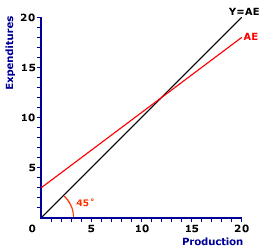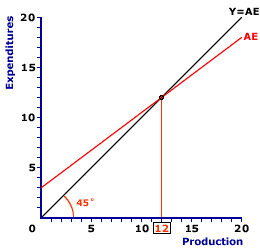
|
|
EQUILIBRIUM, AGGREGATE MARKET: The state of the aggregate market in which real aggregate expenditures are equal to real production, which means that the price level, aggregate expenditures, and/or real production do not change. In other words, the opposing forces of aggregate demand (the buyers) and aggregate supply (the sellers) are in balance.
Visit the GLOSS*arama
|
|


|

|
                           KEYNESIAN DISEQUILIBRIUM: The state of the Keynesian model in which aggregate expenditures are not equal to aggregate production, which results in an imbalance that induces a change in aggregate production. In other words, the opposing forces of aggregate expenditures (the buyers) and aggregate production (the sellers) are out of balance. At the existing level of aggregate production, either the four macroeconomic sectors (household, business, government, and foreign) are unable to purchase all of the production that they seek or producers are unable to sell all of the production that they have. Disequilibrium in Keynesian economics, strictly speaking, means that an overall imbalance exists in the product markets of the macroeconomy. Other macroeconomic markets, especially financial and resource, may or may not be in balance. The imbalance between aggregate expenditures and aggregate production induces a change in business inventories.- If aggregate expenditures are less than aggregate production, then business inventories increase.
- If aggregate expenditures are greater than aggregate production, then business inventories decrease.
Two Aggregate ForcesThe two opposing forces that achieve equilibrium in the Keynesian model of macroeconomics are aggregate production and aggregate expenditures.- Aggregate Production: The first half of the balance is aggregate production, the total quantity of final goods and services produced in the economy. This total or aggregate production is most commonly measured by gross domestic product.
- Aggregate Expenditures: The other half of the equilibrium balance is aggregate expenditures, the combined expenditures on final goods and services undertaken by the four macroeconomic sectors (household, business, government, and foreign). The four aggregate expenditures (and their common abbreviation) are: consumption expenditures (C), investment expenditures (I), government purchases (G), and net exports (X - M). Aggregate expenditures are commonly represented by an simple equation:
An Intersecting Equilibrium| Equilibrium | 
|
As a point of comparison, let's first consider equilibrium in the Keynesian model, which can be accomplished using the exhibit to the right. Equilibrium is achieved at the intersection of the 45-degree line and the aggregate expenditures line. Click the [Equilibrium] button to identify this point and corresponding aggregate production. Equilibrium is achieved with $12 trillion of aggregate production. At this level, aggregate expenditures are also $12 trillion. Only at $12 trillion are aggregate expenditures equal to aggregate production. At every other production level, aggregate expenditures are either greater than or less than aggregate production. Out of BalanceOnce the Keynesian model achieves equilibrium it remains in equilibrium. But what happens if the level of aggregate production does not achieve equilibrium? What if aggregate production is less than or greater than that needed for equilibrium? Fortunately, the Keynesian model has a stable equilibrium. That is, should the model not be in equilibrium it moves toward equilibrium.Disequilibrium in the Keynesian model results when aggregate expenditures are not equal to aggregate production. More specifically, this is an aggregate production level that does not coincide with the intersection of the aggregate expenditures line and the 45-degree line. | Disequilibrium | 
|
A graphical analysis of disequilibrium is in order. The exhibit to the right displays equilibrium in the Keynesian model. Aggregate production is $12 trillion at the intersection of the aggregate expenditures line and the 45-degree line. If aggregate production is greater than or less than $12 trillion, we have disequilibrium. Let's consider each alternative.- Greater Than $12 Trillion: Suppose aggregate production is $18 trillion. Click the [$18 Trillion] button to highlight this alternative. At $18 trillion, the aggregate expenditures line lies beneath the 45-degree line and aggregate expenditures are $16.5 trillion, less than aggregate production.
The difference between aggregate expenditures and aggregate production means that economy-wide production surpluses exist. Economy-wide surpluses result in unplanned increases in inventories because the business sector sells less output than current production. The $1.5 trillion vertical distance between the aggregate expenditures line and the 45-degree line indicates the increase in business inventories. The build-up of inventories motivates the business sector to reduce aggregate production. The decrease in aggregate production then moves the economy to the $12 trillion equilibrium level. In the course of this adjustment, aggregate expenditures decline from $16.5 trillion to $12 trillion.
- Less Than $12 Trillion: Now suppose aggregate production is $6 trillion. Click the [$6 Trillion] button to highlight this alternative. At $6 trillion, the aggregate expenditures line lies above the 45-degree line and aggregate expenditures are $7.5 trillion, greater than aggregate production.
The difference between aggregate expenditures and aggregate production means that economy-wide production shortages exist. Economy-wide shortages result in unplanned decreases in inventories because the business sector sells more output than current production. The $1.5 trillion vertical distance between the aggregate expenditures line and the 45-degree line indicates the decrease in business inventories. The reduction of inventories motivates the business sector to increase aggregate production. The increase in aggregate production then moves the economy to the $12 trillion equilibrium level. In the course of this adjustment, aggregate expenditures rise from $7.5 trillion to $12 trillion.
Changes in business inventories play a key role in the adjustment to equilibrium by signalling the business sector to increase or decrease aggregate production. For this reason, those who track the ups and downs of business cycles tend to keep a close eye on business inventories. A sudden and unexpected drop is a likely sign of an expansion of the economy. A sudden and unexpected rise is a likely sign of a contraction.

Recommended Citation:KEYNESIAN DISEQUILIBRIUM, AmosWEB Encyclonomic WEB*pedia, http://www.AmosWEB.com, AmosWEB LLC, 2000-2025. [Accessed: June 30, 2025].
Check Out These Related Terms... | | | | | | | | | | |
Or For A Little Background... | | | | | | | | | | |
And For Further Study... | | | | | | | | | | | | | |
Search Again?
Back to the WEB*pedia
|



|

|
PURPLE SMARPHIN
[What's This?]
Today, you are likely to spend a great deal of time searching for rummage sales seeking to buy either a birthday greeting card for your mother that doesn't look like a greeting card or a handcrafted spice rack. Be on the lookout for vindictive digital clocks with revenge on their minds.
Your Complete Scope
This isn't me! What am I?
|

|
|
The first paper notes printed in the United States were in denominations of 1 cent, 5 cents, 25 cents, and 50 cents.
|

|
|
"I learned about the strength you can get from a close family life. I learned to keep going, even in bad times. I learned not to despair, even when my world was falling apart. I learned that there are no free lunches. And I learned the value of hard work. " -- Lee Iacocca
|

|
M1
currency and coins held by the nonbank public plus checkable deposits issued by traditional banks, savings and loan associations, credit unions, and mutual savings banks
|

|
|
Tell us what you think about AmosWEB. Like what you see? Have suggestions for improvements? Let us know. Click the User Feedback link.
User Feedback
|


|


